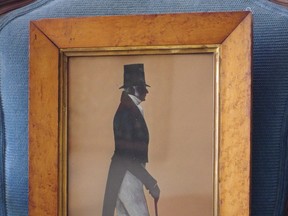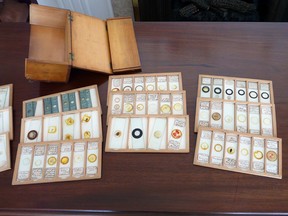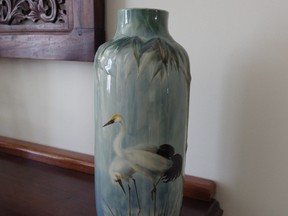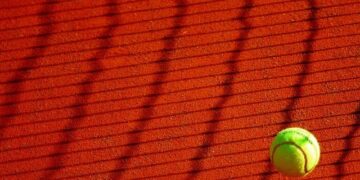Published Apr 26, 2024 • 3 minute read
 Framed silhouette. Photo by Supplied
Framed silhouette. Photo by Supplied
Q This is a silhouette of the Squire of West Haddon, Northamptonshire, UK. He was born in 1783 and died in Shrewsbury in 1871. His daughter married my great grandfather, just to keep family records straight! It appears to be watercolour paints of just black and white on paper, and backed by a wood panel. The frame, measuring 36 by 25 cm (14 x 10 inches) is faced with bird’s eye maple veneer. Is there some interest to add on top of a value? Thank you and best wishes,
Advertisement 2
This advertisement has not loaded yet, but your article continues below.
THIS CONTENT IS RESERVED FOR SUBSCRIBERS ONLY
Subscribe now to read the latest news in your city and across Canada.
Exclusive articles from Elizabeth Payne, David Pugliese, Andrew Duffy, Bruce Deachman and others. Plus, food reviews and event listings in the weekly newsletter, Ottawa, Out of Office.Unlimited online access to Ottawa Citizen and 15 news sites with one account.Ottawa Citizen ePaper, an electronic replica of the print edition to view on any device, share and comment on.Daily puzzles, including the New York Times Crossword.Support local journalism.
SUBSCRIBE TO UNLOCK MORE ARTICLES
Subscribe now to read the latest news in your city and across Canada.
Exclusive articles from Elizabeth Payne, David Pugliese, Andrew Duffy, Bruce Deachman and others. Plus, food reviews and event listings in the weekly newsletter, Ottawa, Out of Office.Unlimited online access to Ottawa Citizen and 15 news sites with one account.Ottawa Citizen ePaper, an electronic replica of the print edition to view on any device, share and comment on.Daily puzzles, including the New York Times Crossword.Support local journalism.
REGISTER / SIGN IN TO UNLOCK MORE ARTICLES
Create an account or sign in to continue with your reading experience.
Access articles from across Canada with one account.Share your thoughts and join the conversation in the comments.Enjoy additional articles per month.Get email updates from your favourite authors.
Sign In or Create an Account
or
Article content
Geoff, Waterloo, Ont.
Article content
A The moniker of ‘silhouette’ – for shadowed profiles – has been credited, with some reservation to Louis XV’s frugal finance minister, Etienne de Silhouette who enacted drastic fiscal reforms to finance the Seven Years’ War (1756-1763) – suggesting these to be less expensive portraiture. They were known earlier as ‘shades’ – a process involving candlelight shadows thrown onto oiled paper which were traced in pencil. Outlines were transferred to black paper to cut out or apply to lighter paper then shaded with black and white – as in yours. Appearing in the 17th century they were popular until about 1850 when they were eclipsed by the more modern photograph. Silhouettes are more affordable today but still find settings with country décor. Your fine example, with the ‘ID’ is worth $600 today.
 Microscope slides. Photo by Supplied
Microscope slides. Photo by Supplied
Q This set of almost 70 microscope slides from the 1800s includes 12 novelty slides, the original “microdot” efforts showing the royal family, Niagara Falls, Gladstone etc. Many are labelled with specimen name, preserving medium, date, and the preparer. They were purchased purchased in England, during World War II. I’m having fun going through them and I hope they catch your attention.
Advertisement 3
This advertisement has not loaded yet, but your article continues below.
Article content
Paul, Kingston, Ont.
A Often referred to as “The Father of Microbiology” Antonie van Leeuwenhoek was finally recognized for his accomplishments of the late 1600s, by the general public about 200 years later. Companies promoting the sale of microscopes often sold accessory slide sets, and the public was eager to learn about these new “invisible to the naked eye” wonders. Exhibition slides often consisted of artistically arranged diatoms, or colourful insect scales in snowflake shapes or floral bouquets. The “microdots” you mention – extremely reduced photographs requiring a microscope to view, and once said to have been used for espionage – are of much interest and quite collectible. These sets were popular from the early 1900s and with more interest in science today collectors will often pay quite a high price for particular individual slide subjects. Your collection could be worth $275.
 Crane vase. Photo by Supplied
Crane vase. Photo by Supplied
Q This 25 cm (10 inch) high vase came back to Canada from China with my mother-in-law. She brought it to Canada when she left China. It is marked “Titanian” on the bottom as well as Royal Doulton. The name F. Henri is painted on the side of the vase to the bottom right of the cranes. Can you tell me anything about its history and value? Thank you.
Advertisement 4
This advertisement has not loaded yet, but your article continues below.
Article content
Lois, Kitchener, Ont.
A F. Henri was one of Doulton’s top artists who painted stunning animal subjects on porcelain, including these lovely Asian-style cranes. The Doulton firm, founded in the early 1800s, owes much of its competitive success to hiring artists with talent and flair. The quality of this piece is terrific, and its visual impact is enhanced by the smoky blue “Titanian” glaze, first derived from titanium oxide around 1915. Bird subjects done by known artists are popular today, even though many Doulton products have reduced values, presently. This special piece will command $650 today.
John Sewell is an antiques and fine art appraiser. To submit an item to his column, go to the ‘Contact John’ page at www.johnsewellantiques.ca. Please measure your piece, say when and how you got it, what you paid and list any identifying marks. A high-resolution jpeg photo must also be included. (Only email submissions accepted.)
* Appraisal values are estimates only.*
Article content
>>> Read full article>>>
Copyright for syndicated content belongs to the linked Source : OttawaCitizen – https://ottawacitizen.com/life/antiques-artwork-answers-whats-in-a-name-question






























